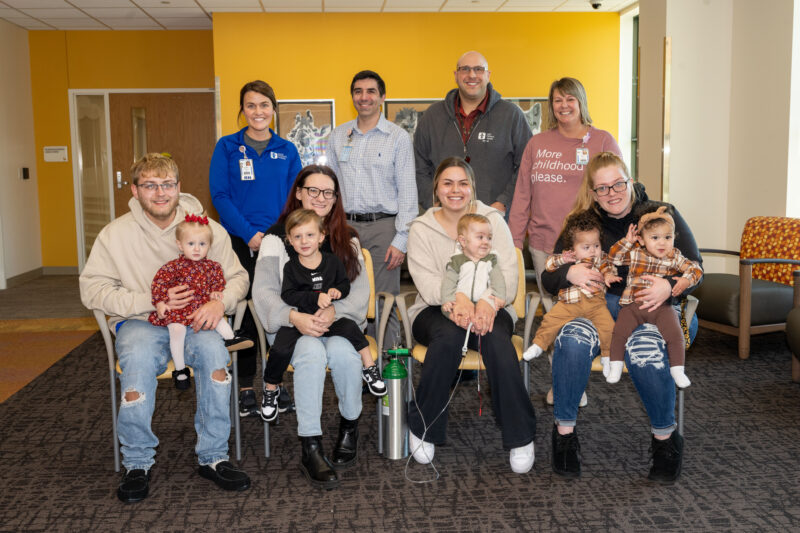
Back row L-R: Hannah Miller, Neurology nurse program coordinator; Dr. Matthew Ginsberg, Dr. Ian Rossman, social worker Noelle Buso. Not pictured: Dr. Kathryn Mosher. Front row: Jordan & Nevaeh Moorhead holding Harlow and Jordan; Eve Freeman holding Marshall; Rebecca Mulhall holding Antonio and Estella-Rose. Not pictured Jessica Burchett and William Ivery with Kali and Kaiden.
There’s a saying, “Timing is everything in life.”
This could not be more true for Kali and Kaiden, Antonio and Estella-Rose, Marshall, and Harlow (plus her big brother Jordan) – babies born with Spinal Muscular Atrophy (SMA) who have received a gene therapy at Akron Children’s, since it was approved by the FDA in May 2019.
“They look absolutely amazing,” said pediatric physiatrist Dr. Kathryn Mosher, who recently had appointments with all of the babies and remembered they all got their life-changing infusions of Zolgensma ® within weeks of each other about a year ago.
SMA is an inherited disease that causes muscles to weaken and waste away. The children are born with a missing protein that is required for the survival of the cells in the spinal cord responsible for movement. This is the focus of current treatments. The gene therapy replaces the gene that produces that protein and two other therapies on the market increase production of the protein from back-up copies of that gene.
And, so far, the results have been remarkable.
“I thought it was important to highlight this moment, because we are literally watching history being rewritten,” Dr. Mosher said. “Each of these precious children would have had a much different path just a few years ago. But now, due to amazing advances in our ability to treat SMA, kids who may not have survived past the age of 2 are not only surviving but thriving.”
Dr. Mosher said she recently had the opportunity to speak at a national conference and share a video of a child, now age 3, born with the most severe form of SMA, who has benefitted from two of the three available treatments. In the video, the child was walking and laughing.
“The audience was in awe,” Dr. Mosher recalled. “Some stood up and gave a standing ovation, because they remember when all we could do was send these babies home to be loved until they died. It was an emotional moment. These are the days we hardly dared to dream of. I feel so privileged to be part of it all.”
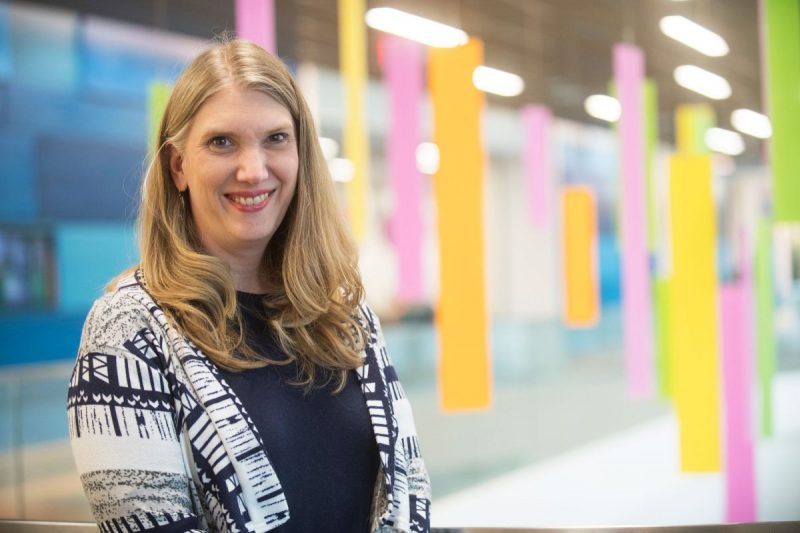
Dr. Kathryn Mosher
Inside Children’s recently checked in with these families to learn about their journey – and got them together for a photo. Here are their stories.
Kali and Kaiden Ivery
Twins Kali and Kaiden were 4 weeks old when they had their gene therapy infusion.
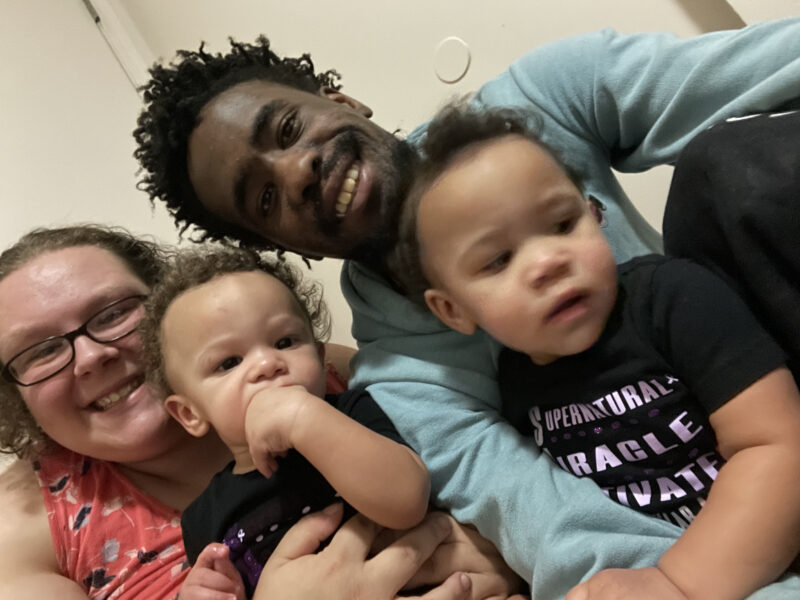
Jessica Burchett and William Ivery with Kaiden and Kali.
“We were told our kids may not ever crawl, walk or talk,” said their mom Jessica Burchett, of Akron. “But we are at 12 months now, and they are crawling all around and both babies are trying to walk. They are doing really well.”
The twins were in the Akron Children’s NICU at Summa, about to be discharged, when their newborn screen panel came back with the SMA diagnosis for both babies.
“Honestly, I went numb,” Jessica said. “I have a friend who has a child with SMA, so I knew what that meant. I thought I was going to lose my children. It was hard news on top of just having twins and still being in the postpartum period. It was a lot.”
Hope came to Jessica and the twins’ dad, William, with their first visit to the NeuroDevelopmental Science Center at Akron Children’s when Dr. Ginsberg explained the new therapies recently coming out of clinical trials, including Zolgensma. It would then just be a bit of a waiting game to make sure they qualified for the therapy and insurance coverage.
“At first we were scared to give it to them, because they were so small but, Zolgensma has done wonders for my children,” said Jessica. “They are one year now and doing above and beyond what is expected.”
Antonio and Estella-Rose Wright
Rebecca Mulhall, of Cleveland, got the news at 12 weeks in her pregnancy that one of her twins was at high risk for Down syndrome. She said she cried a little due to fear of possible struggles, but then remembered the beauty that has come from every challenge. Antonio and Estella-Rose were born and were doing relatively well when the next big thing hit.
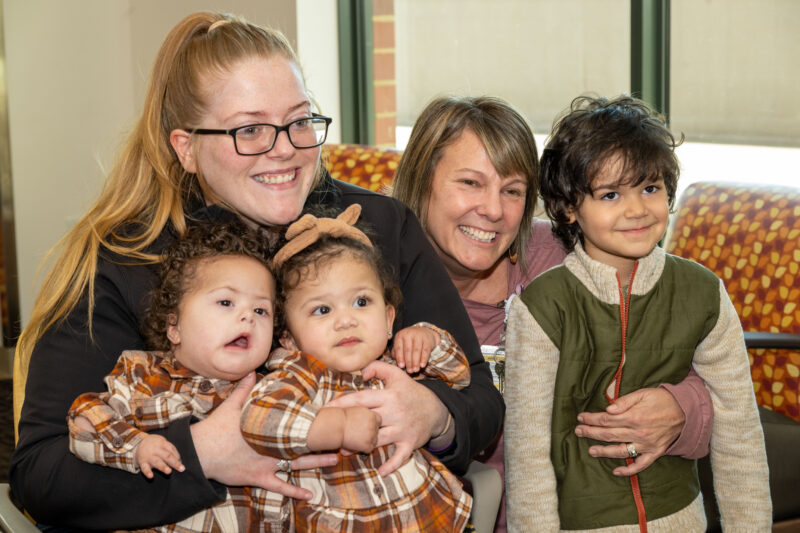
Rebecca Mulhall welcomes social worker Noelle Buso in for hugs with twins Antonio and Estella Rose and older brother Sean, 4.
A doctor told her both twins had tested positive for SMA Type 1. At first it seemed like no big deal until the doctor explained what exactly that meant for their future.
“I just instantly bursted into tears,” Rebecca said. She heard phrases like “without treatment, babies not making it past six months,” “kids not seeing their 2nd birthday.”
“I was hearing all of this before they were even one month old,” she said.
The twins were referred to Akron Children’s. Rebecca said meeting social worker Noelle Buso “quickly made our lives 10 times easier throughout this process.”
Drs. Ian Rossman and Matthew Ginsberg explained that the twins were eligible for Zolgensma, a one-time infusion. Antonio also benefits from a daily treatment of Evrysdi ®
Rebecca said Estella-Rose is doing wonderful, and, although things are “ten times harder for Antonio,” doctors are still very happy with his progress. Seeing how far he’s come makes Rebecca especially happy.
“Antonio has been my reminder to never give up fighting,” she said. “And Estella-Rose has been my reminder to lead the way for all of us. The twins haven’t given up yet. Why should I?”
Marshall Bowling
Eve Freeman, of Millersburg, had brought baby Marshall to his first pediatrician appointment when the doctor shared concerns from his newborn screening.
“There were some abnormal findings, SMA,” she said. “We weren’t told much about it but were referred to Genetics and Neurology at Akron Children’s. We learned about the Zolgensma, but had to do blood work to see if he was even eligible for it. It was all scary. We are young, first-time parents.”
Eve and boyfriend, Colton, learned more about SMA with their first appointments at Akron Children’s but also new therapies. Then the waiting game started. Marshall had to be approved with clinical steps like bloodwork and also through insurance.
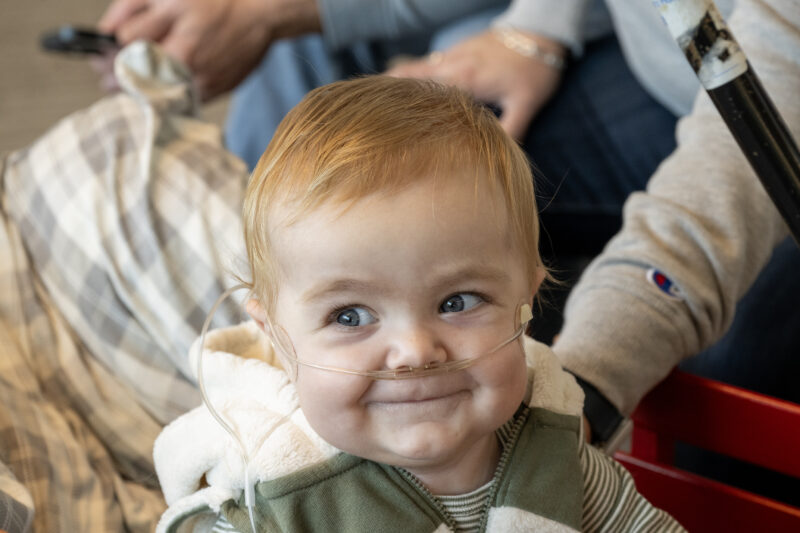
Marshall Bowling, all smiles, and cruising towards his first birthday.
“Every single day was full of stress waiting and wanting things to hurry up, because we feared ‘whatever he’s lost, he’s lost and won’t be able to gain it back,’” she said.
He received his Zolgensma at one month and takes a daily dose of Evrysdi.
Marshall is now 11 months and holding his head up and sitting up on his own. He had a set-back in September with some respiratory concerns and was hospitalized. He’s still getting some oxygen but doing well.
“He babbles like crazy and just learned how to shake his head, ‘No,’” said Eve. “He loves to bounce and loves to smile.”
Jordan & Harlow Moorhead
Nevaeh and Jordan Moorhead, of Warren, learned that their now 2-year-old son, Jordan, had SMA Type 2 after he was born and received his infusion of Zolgensma at 5 weeks.
They learned through amniocentesis during Nevaeh’s pregnancy that baby sister, Harlow, would also have it. Harlow got her treatment at 4 weeks and just recently celebrated her first birthday.
At age 2, Jordan is hitting his developmental milestones.
“He is right on track,” said Nevaeh.
Harlow started crawling a little late and has a weaker muscle tone.
“But physical therapy will help with that,” said Nevaeh. “She pulls herself up on everything and gets into everything.”
Nevaeh said she thinks often about how lucky she feels that this new gene therapy was available when her children were born and that her family lives within a close drive of a medical team with the expertise to lead her family through it.
“I am very thankful for the team at Akron Children’s because, without them, I don’t know what would have happened,” she said. “Drs. Ginsberg and Rossman made the process so easy.”
Nevaeh said when she first got the news about Jordan she was angry with God and then she was angry again when she got the same terrible news about Harlow.
“But they are my miracles,” she said. “I love them and wouldn’t trade them for the world. I am grateful for this amazing science.”
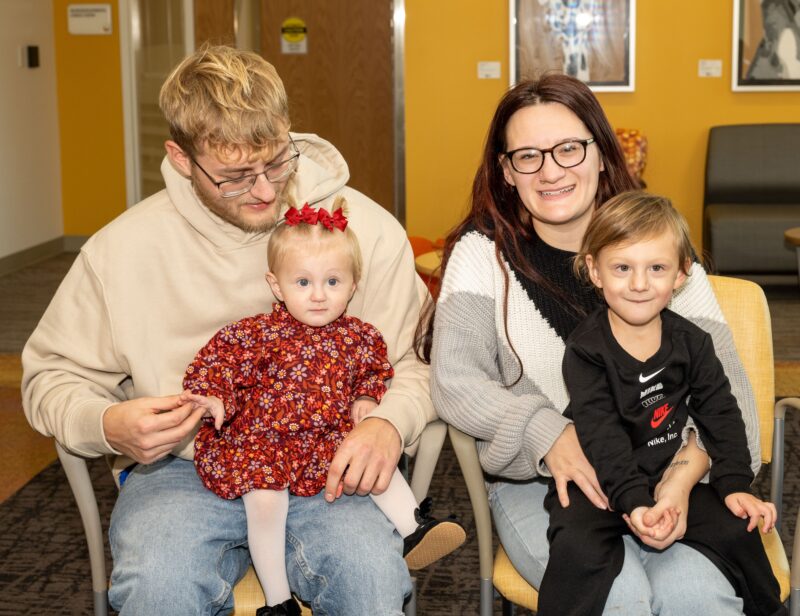
The Moorhead family of Warren: Jordan and Nevaeh, Harlow and Jordan.
Newborn Screening
The state of Ohio is part of the SMA newborn screen. All families are offered an opportunity through newborn screening to find out quickly if their child is affected. Additionally, screening for carrier status is widely available for expectant parents. We encourage all families to accept the free newborn screening offered at birth. Treatment for SMA should begin ideally within a month of birth, because the disease is present at birth and continues to progress. Early treatment allows for the best possible likelihood of a good outcome. For more information, visit curesma.org










